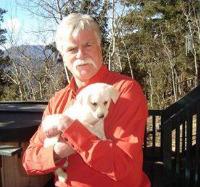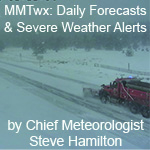- Posts: 2915
- Thank you received: 3
Science Odds and Ends
- Grady
-

- Mountain Legend
-

pretty cooldaisypusher wrote:
On Dec. 6th, a magnetic filament stretching more than 700,000 km around the sun's southeastern limb erupted, producing a blast of epic proportions
http://spaceweather.com/images2010/06dec10/epicblast2.gif?PHPSESSID=qhnecot3dg2f76jtp7c1rotma0
Please Log in or Create an account to join the conversation.
- TPP
-

- User is blocked
-

- Posts: 4760
- Thank you received: 0
http://www.junkscience.com/
CFL makers rise to defend incandescent bulb ban
Compact fluorescent lightbulb (CFL) makers Philips Electronics, Osram Sylvania and General Electric are scrambling to defend the looming ban on incandescent light bulbs, according to Climatewire.
{ http://www.eenews.net/ }
Philips has sent halogen bulbs to members of Congress and conservative columnists like George Will in an effort to show that CFLs are not the only option to incandescents. Sure, halogens and LEDs are options, but expensive and inferior ones. Try putting LED lights on your Christmas tree — they’re about as aesthetically pleasing as a migraine.
Sylvania is trying to convince people that the 2007 legislation — sponsored by let’s-hope-he’s-not-a-RINO Rep. Fred Upton (R-Mich), the chairman-elect of the House Energy and Commerce Committee, and signed by the accursed, lame-memoir-hawking George Bush — is not a ban at all. In January 2012, however, you won’t find any 100-watt incandescents on store shelves. In January 2014, 40-watt bulbs will be history. How is this not a ban?
Consumers, in fact, have more choices, says Sylvania. Perhaps, but they’re getting a lot worse.
Philips, Sylvania and GE all lobbied Congress into forcing us to buy more expensive and inferior lighting — all in the name of saving the planet from the dreaded global warming.
Moreover, CFLs are handblown by poor, low-wage Chinese bastards who reportedly
{ http://greenhellblog.com/2009/05/05/green-lightbulbs-poison-workers/ } are being poisoned by the mercury.
And no, Upton doesn’t get any points for any meaningless regret he expresses or futile effort he may make to repeal the ban. The Senate likely will not pass and/or Obama likely will veto any such bill. You can bet that the CFL makers will make sure of that.
In the next world, may the CEOs and lobbyists of Philips, Sylvania, and GE; Fred Upton and the members of the 110th Congress who voted for the ban; and the accursed George Bush be compelled to read W’s biography ad infinitum by humming and flickering CFL-light. (Green Hell Blog).
Please Log in or Create an account to join the conversation.
- ScienceChic
-
 Topic Author
Topic Author
- Mountain Champion
-

- Posts: 15745
- Thank you received: 320
http://www.sciencemag.org/content/330/6010/1530.short
Thought for Food: Imagined Consumption Reduces Actual Consumption
Carey K. Morewedge*, Young Eun Huh and Joachim Vosgerau
Science 10 December 2010:
Vol. 330 no. 6010 pp. 1530-1533
DOI: 10.1126/science.1195701
The consumption of a food typically leads to a decrease in its subsequent intake through habituation—a decrease in one’s responsiveness to the food and motivation to obtain it. We demonstrated that habituation to a food item can occur even when its consumption is merely imagined. Five experiments showed that people who repeatedly imagined eating a food (such as cheese) many times subsequently consumed less of the imagined food than did people who repeatedly imagined eating that food fewer times, imagined eating a different food (such as candy), or did not imagine eating a food. They did so because they desired to eat it less, not because they considered it less palatable. These results suggest that mental representation alone can engender habituation to a stimulus.
Don't forget the meteor showers tonight!
"Now, more than ever, the illusions of division threaten our very existence. We all know the truth: more connects us than separates us. But in times of crisis the wise build bridges, while the foolish build barriers. We must find a way to look after one another as if we were one single tribe.” -King T'Challa, Black Panther
The truth is incontrovertible. Malice may attack it. ignorance may deride it, but in the end, there it is. ~Winston Churchill
Please Log in or Create an account to join the conversation.
- pineinthegrass
-

- Mountain Legend
-

- Posts: 2836
- Thank you received: 25
At least it's not too cold right now, 40 deg, not bad!
Please Log in or Create an account to join the conversation.
- ScienceChic
-
 Topic Author
Topic Author
- Mountain Champion
-

- Posts: 15745
- Thank you received: 320
http://www.sciencemag.org/site/special/insights2010
The 17 December 2010 issue of Science includes special sections highlighting the Breakthrough of the Year and Insights of the Decade. Access to this content is FREE with a simple registration.
Breakthrough of the Year
The First Quantuum Machine http://www.sciencemag.org/content/330/6011/1604.short
The Runners-Up http://www.sciencemag.org/content/330/6011/1605.shortUntil now, all machines have moved according to the not-surprising laws of classical mechanics, which govern the motion of everyday objects. In contrast, a tiny machine unveiled this year jiggles in ways explicable only by the weird rules of quantum mechanics, which ordinarily govern molecules, atoms, and subatomic particles. The proto-quantum machine opens the way to myriad experimental devices and perhaps tests of our sense of reality. That potential and the ingenuity of the experiment make it the Breakthrough of the Year.
Areas to Watch in 2011 http://www.sciencemag.org/content/330/6011/1608.3.shortA synthetic genome inserted into a bacterium in place of the organism's original DNA and the two-thirds-complete Neandertal genome sequence topped the list of this year's runners-up for Breakthrough of the Year. Other notable discoveries included next-generation genomics, souped-up cellular reprogramming, exome sequencing, quantum simulators, molecular dynamics simulations, knockout rats, and HIV prophylaxis.
In 2011, Science's editors will be watching a smaller detector at the Large Hadron Collider called LHCb, which will study B mesons in great detail; new techniques that should lead to the discovery of many more genes contributing to adaptation; an ignited fusion burn at the National Ignition Facility; broadly neutralizing antibodies, which are capable of disabling a wide range of viral variants; the first plug-in hybrid electric cars whose batteries are charged from a wall socket go on the market; and the results of the first phase III trial of a malaria vaccine.
Introduction - Insights of the Decade
Stepping Away From the Trees For a Look at the Forest
by Science News Staff
Science's news staff takes a break from reporting to review some big ideas of the past 10 years and the technologies that made them possible.
The Dark Genome
Since the publication of the human genome sequence in 2001, scientists have found that the so-called junk DNA that lies between genes actually carries out many important functions.
Precision Cosmology
In the past decade, cosmologists have deduced a very precise recipe for the content of the universe, as well as instructions for putting it together, transforming cosmology from a largely qualitative endeavor to a precision science with a standard theory.
Ancient DNA
Scientists have been giving us new views of the prehistoric world in the past decade that hinge on the realization that "biomolecules" such as ancient DNA and collagen can survive for tens of thousands of years and give important information about long-dead plants, animals, and humans.
Water on Mars
The past decade's half-dozen martian missions have made it clear that early in Mars history, liquid water on or just inside the planet did indeed persist long enough to alter rock and, possibly, sustain the origin of life.
Reprogramming Cells
By prompting a cell to overexpress a few genes, researchers have discovered in the past decade how to turn a skin or blood cell into a pluripotent cell: one that has regained the potential to become any number of cells in the body.
The Microbiome
This past decade has seen a shift in how we see the microbes and viruses in and on our bodies, most of which are commensal and just call the human body home; collectively, they have come to be called the human microbiome.
Exoplanets
Data on the 500-and-counting planets discovered outside of our solar system in the past decade are revolutionizing researchers' understanding of how planetary systems form and evolve.
Inflammation
Over the past decade, it has become widely accepted that inflammation is a driving force behind chronic diseases that will kill nearly all of us: cancer, diabetes and obesity, Alzheimer's disease, and atherosclerosis.
Metamaterials
In the past decade, physicists and engineers pioneered new ways to guide and manipulate light, creating lenses that defy the fundamental limit on the resolution of an ordinary lens and even constructing "cloaks" that make an object invisible-sort of.
Climate Change Research
In the past few years, climate scientists finally agreed that the world is indeed warming, humans are behind it, and natural processes are unlikely to rein it in-just as they had suspected.
Science Talk
Readers' Picks: Your Breakthrough Nominations
Highlights from the Science Talk page. http://talk.sciencemag.org/nodes/btoy2010.html
Science Podcast
The year's top scientific breakthrough and some of the big ideas from the past decade. Listen Now
http://podcasts.aaas.org/science_podcas ... 101217.mp3
"Now, more than ever, the illusions of division threaten our very existence. We all know the truth: more connects us than separates us. But in times of crisis the wise build bridges, while the foolish build barriers. We must find a way to look after one another as if we were one single tribe.” -King T'Challa, Black Panther
The truth is incontrovertible. Malice may attack it. ignorance may deride it, but in the end, there it is. ~Winston Churchill
Please Log in or Create an account to join the conversation.
- ScienceChic
-
 Topic Author
Topic Author
- Mountain Champion
-

- Posts: 15745
- Thank you received: 320
Top 10 ScienceNOWs of 2010
by David Grimm on 16 December 2010
My faves:Every year, ScienceNOW compiles a Top 10 list of our favorite and most popular stories. As usual, the 2010 batch is an eclectic mix. And this year's list contains something special: our most popular story of all time.
#9 Superaccurate clocks confirm your hair is aging faster than your toenails - Researchers have used ultraprecise clocks to show that time flies faster for your nose than for your navel—an effect predicted by the famed physicist's theory of relativity.
#8 The shocking truth about running shoes - Don't like your running shoes? Toss 'em. Running barefoot may actually be better for your feet, according to a study.
#6 The Spiky Penis Gets the Girl - When it came to insect penises, Charles Darwin had it right. That's all we're going to tell you, except that this story involves a laser directed at genitalia.
#2 These Dance Moves Are Irresistible - Hey, guys, want to impress ladies on the dance floor? These videos could help—unless you agree with some of our skeptical commenters.
"Now, more than ever, the illusions of division threaten our very existence. We all know the truth: more connects us than separates us. But in times of crisis the wise build bridges, while the foolish build barriers. We must find a way to look after one another as if we were one single tribe.” -King T'Challa, Black Panther
The truth is incontrovertible. Malice may attack it. ignorance may deride it, but in the end, there it is. ~Winston Churchill
Please Log in or Create an account to join the conversation.
- ScienceChic
-
 Topic Author
Topic Author
- Mountain Champion
-

- Posts: 15745
- Thank you received: 320
How Landslides Get Slippery
by Sid Perkins on 19 December 2010
when the flume sediments were almost or fully saturated, the landslide grew explosively, in some cases ending up with four times the momentum of the original sediment dump (see video). In these cases, sensors revealed, the pressure of the overriding material boosted water pressure in the underlying sediments in less than 1 second, nearly liquefying them and dramatically decreasing any friction that might slow down the flow. As a result, flume sediments eroded and joined the accelerating, ever-swelling flow.
Many scientists have long suspected that water plays a big role in landslide behavior, says Anne Mangeney, a geophysicist at the Institute of Geophysics of Paris, who wasn't involved in the research. But until now, she notes, no one had come up with hard data to quantify the effect.
http://news.sciencemag.org/scienceinsid ... tml?ref=hp
Politics Buried Science in Louisiana Sand Berms, Oil Commission Finds
by Erik Stokstad on 17 December 2010
The idea to guard against this year's BP oil spill in the Gulf of Mexico by building offshore sand berms was controversial from the start, and scientists voiced many concerns about the project. A new report (pdf) from a presidential commission investigating the spill now reveals how intense political pressure overrode experts' concerns that the berms would be ineffective--which ultimately proved correct.
Although Louisiana's governor, Bobby Jindal, has publicly declared success, the report, released yesterday, concludes otherwise. "From the perspective of the Commission staff, however, $220 million for a spill response measure that trapped not much more than 1,000 barrels of oil is not a compelling cost-benefit tradeoff," it says. With just 1000 barrels of oil collected—compared with as much as 1.85 million collected via other methods—the presidential commission concludes that the berms "were not a success." The reason they got built, the commission concludes, is because politics got the best of science.
http://news.sciencemag.org/scienceinsid ... aited.html
White House Releases Long-Awaited Guidance for Scientific Integrity
by Erik Stokstad on 17 December 2010
Seventeen months late on meeting the deadline set in a March 2009 order from President Barack Obama, the White House Office of Science and Technology Policy (OSTP) today released high-level guidance for federal agencies on how to develop policies on scientific integrity. The guidance, which includes a prohibition on political interference, is being received warmly but somewhat cautiously by advocacy groups.
The guidance includes the following points:
* "Political officials should not suppress or alter scientific or technological findings."
* Data used for policy decisions should "undergo independent peer review by qualified experts, where feasible and appropriate."
* Agencies should set clear standards for dealing with conflict of interest and adopt whistleblower protections.
* Agencies should expand and promote access to scientific information by making it available online.
* There should be principles for communicating science to the public, such as explaining uncertainties and describing the probabilities of best- and worst-case scenarios.
* Federal scientists can speak to the media and public about their research "with appropriate coordination with their immediate supervisor and their public affairs office."
* Agencies should facilitate professional development of scientists, such as encouraging publication of results and presentations at meetings.
http://news.sciencemag.org/scienceinsid ... ow-us.html
'Come Hell or High Water': How U.S. and U.K. Scientists Got to Map East Antarctica
by Eli Kintisch on 17 December 2010, 4:39
A presentation at the American Geophysical Union here yesterday offered preliminary findings from a 5-year project to map the subglacial topography of East Antarctic. And while ICECAP will add to the growing evidence that much more of the East Antarctic ice sheet sits below sea level than had once been thought, how the researchers were able to get there is a story in and of itself.
The scientists came up with a proposal for NSF to pay the salaries of U.S. researchers involved in the project, while the U.K. National Environment Research Council would provide logistical and scientific support, including a World War II-era plane and ground support. The Australian government, which operates a base with two ice runways on the Aurora Basin, was also interested in the project. The total cost of the project is about $1 million a year, incredibly cheap by Antarctic standards because the team was able to avoid the need for expensive C-130 flights by relying on coastal bases that are supplied by ship.
And while vast amounts of data must still be collected and analyzed, the bottom line is already clear. "Much more of the bottom of East Antarctica is below sea level than we expected," he said, "and significant portions are in contact with the ocean." Those findings suggest that East Antarctica is much more susceptible to climate change than scientists had once thought.
"Now, more than ever, the illusions of division threaten our very existence. We all know the truth: more connects us than separates us. But in times of crisis the wise build bridges, while the foolish build barriers. We must find a way to look after one another as if we were one single tribe.” -King T'Challa, Black Panther
The truth is incontrovertible. Malice may attack it. ignorance may deride it, but in the end, there it is. ~Winston Churchill
Please Log in or Create an account to join the conversation.
- ScienceChic
-
 Topic Author
Topic Author
- Mountain Champion
-

- Posts: 15745
- Thank you received: 320
Genomes for wild strawberries and fine cacao sequenced
By Katherine Harmon | Dec 26, 2010 01:00 PM
http://www.scientificamerican.com/podca ... r-10-12-25
The Strongest Predictor For Low Stress
Research from wild baboons provides insight into perhaps the best way to combat daily, psychological stress. During this holiday season it might bring some comfort.
Christie Nicholson December 25, 2010
Robert Sapolsky, Professor of Neurology at Stanford University, has been studying stress in wild baboons for more than three decades. And he found there are two powerful predictors of who will be most affected by stress. Personality plays a huge role. Can you tell the difference between a big threat and minor issue? If it is big can you figure out a way to get some control over it? If there’s a bad outcome do you have a coping mechanism? If you can answer yes to these it’s a good bet you’ve got relatively low stress.
Beyond personality traits, the single best predictor of an ability to deal well with stress is how socially connected you are. Baboons who had strong relationships also had low glucocorticoid levels and outlived the more isolated baboons by about three years.
"Now, more than ever, the illusions of division threaten our very existence. We all know the truth: more connects us than separates us. But in times of crisis the wise build bridges, while the foolish build barriers. We must find a way to look after one another as if we were one single tribe.” -King T'Challa, Black Panther
The truth is incontrovertible. Malice may attack it. ignorance may deride it, but in the end, there it is. ~Winston Churchill
Please Log in or Create an account to join the conversation.
- ScienceChic
-
 Topic Author
Topic Author
- Mountain Champion
-

- Posts: 15745
- Thank you received: 320
http://www.scientificamerican.com/podca ... r-10-12-28
Self-Reported Empathy Dropped Over Last 30 Years
Analysis of some 14,000 college student surveys over the last three decades finds that self-reported levels of empathy for others have decreased. Steve Mirsky reports.
December 28, 2010
Start reading more books to your kids! :thumbsup:As you get jostled in the daily rough and tumble, does it feel like other people care less about how rough you have it and how much you’re getting tumbled? Because according to an article in Scientific American Mind magazine, analysis of surveys of college kids reveals that self-reported empathy has been dropping for the last 30 years. And empathy really took a nosedive in the last 10 years.
One possible explanation is social isolation—we tend to do more things on our own and engage in fewer group activities than we used to. Another possible cause is a decrease in reading fiction for pleasure. Studies have found that the number of stories preschoolers read correlates with their ability to understand other people’s emotional states. The good news is that if empathy can go down, it can also go back up. You feel me?
I love reviews because in a field that's not my expertise, they summarize all the recent discoveries in an easy-to-read format (less technical jargon than usual)! During recent years, it's become clearer that our gut flora do more than just help us break down and absorb food - they actively participate in, sometimes helpfully, sometimes detrimentally, our immune response to infections and even unrelated chronic diseases, like diabetes. This paper is pay-per-access, but I highly recommend it if you have an interest in learning more about auto-immunity and adaptive immunity especially.
http://www.sciencemag.org/content/330/6 ... 8.abstract
Has the Microbiota Played a Critical Role in the Evolution of the Adaptive Immune System? * Review
Science 24 December 2010:
Vol. 330 no. 6012 pp. 1768-1773
DOI: 10.1126/science.1195568
Yun Kyung Lee and Sarkis K. Mazmanian*
We are (fortunately) not alone: Humans provide residence to numerous microbial communities comprising hundreds of individual bacterial species. Although teleological design may predict that the immune system evolved to eliminate infectious microbes, we now know that almost every environmentally exposed surface of our bodies is teeming with symbiotic microbes (Fig. 1). These polymicrobial communities contribute profoundly to the architecture and function of the tissues they inhabit and thus play an important role in the balance between health and disease.
Understanding human coevolution with our microbiota may lead to a philosophical and conceptual redefinition of the microbial world and may yield clinical advances toward the treatment of autoimmunity and inflammatory diseases by harnessing the immunomodulatory properties of human commensal bacteria.
http://www.scientificamerican.com/artic ... onnections
100 Trillion Connections: New Efforts Probe and Map the Brain's Detailed Architecture
The noise of billions of brain cells trying to communicate with one another may hold a crucial clue to understanding consciousness
By Carl Zimmer | December 29, 2010
Some neuroscientists dedicate their careers to the workings of individual neurons. Others choose a higher scale: they might, for example, look at how the hippocampus, a cluster of millions of neurons, encodes memories. Others might look at the brain at an even higher scale, observing all the regions that become active when we perform a particular task, such as reading or feeling fear. But few have tried to contemplate the brain on its many scales at once. Their reticence stems, in part, from the sheer scope of the challenge. The interactions between just a few neurons can be a confusing thicket of feedbacks. Add 100 billion more neurons to the problem, and the endeavor turns into a cosmic headache.
Yet some neuroscientists think it is time to tackle the challenge. They argue that we will never truly understand how the mind emerges from our nervous system if we break the brain down into disconnected pieces. Looking only at the parts would be like trying to figure out how water freezes by studying a single water molecule. “Ice” is a meaningless term on the scale of individual molecules. It emerges only from the interaction of a vast number of molecules, as they collectively lock into crystals.
"Now, more than ever, the illusions of division threaten our very existence. We all know the truth: more connects us than separates us. But in times of crisis the wise build bridges, while the foolish build barriers. We must find a way to look after one another as if we were one single tribe.” -King T'Challa, Black Panther
The truth is incontrovertible. Malice may attack it. ignorance may deride it, but in the end, there it is. ~Winston Churchill
Please Log in or Create an account to join the conversation.
- major bean
-

- Mountain Legend
-

- Posts: 2612
- Thank you received: 0
Another dud, useless survey. Science for morons.
Regards,
Major Bean
Please Log in or Create an account to join the conversation.






